Qualitative and Quantitative Research Methods in Health Report
VerifiedAdded on 2023/06/18
|9
|2647
|179
Report
AI Summary
This report provides a comprehensive analysis of qualitative and quantitative research methods, exploring their theoretical approaches, methodologies, and differences. It delves into the theoretical underpinnings of both approaches, highlighting deductive reasoning in quantitative research and ethnographic, phenomenological, field research, and grounded theory in qualitative research. The report discusses various approaches to social sciences, including positivism, interpretive social science, and critical social science. It also outlines specific methods used in quantitative research (descriptive, correlational, causal-comparative, and experimental) and qualitative research (participant observation, in-depth interviews, and focus groups). The document further contrasts the two methodologies based on analytical objectives, question formats, data formats, and flexibility in study design. The report includes a discussion of arguments from quantitative and qualitative articles related to COVID-19 and mental health, emphasizing the different ways data is presented and interpreted in each approach. The conclusion summarizes the key differences and applications of both research methods, highlighting the importance of choosing the appropriate method based on the research question and objectives. Desklib offers a wealth of similar solved assignments and past papers for students.
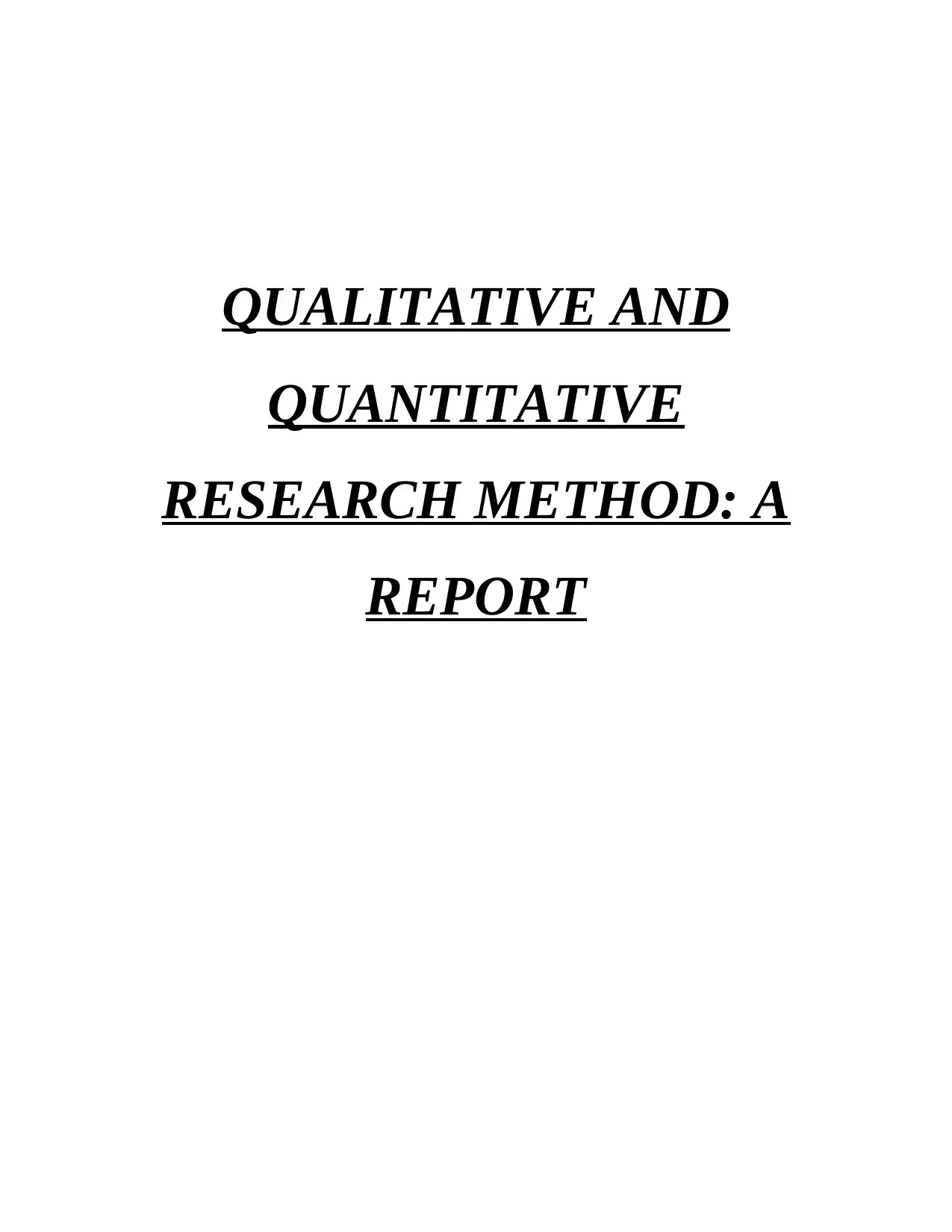
QUALITATIVE AND
QUANTITATIVE
RESEARCH METHOD: A
REPORT
QUANTITATIVE
RESEARCH METHOD: A
REPORT
Paraphrase This Document
Need a fresh take? Get an instant paraphrase of this document with our AI Paraphraser
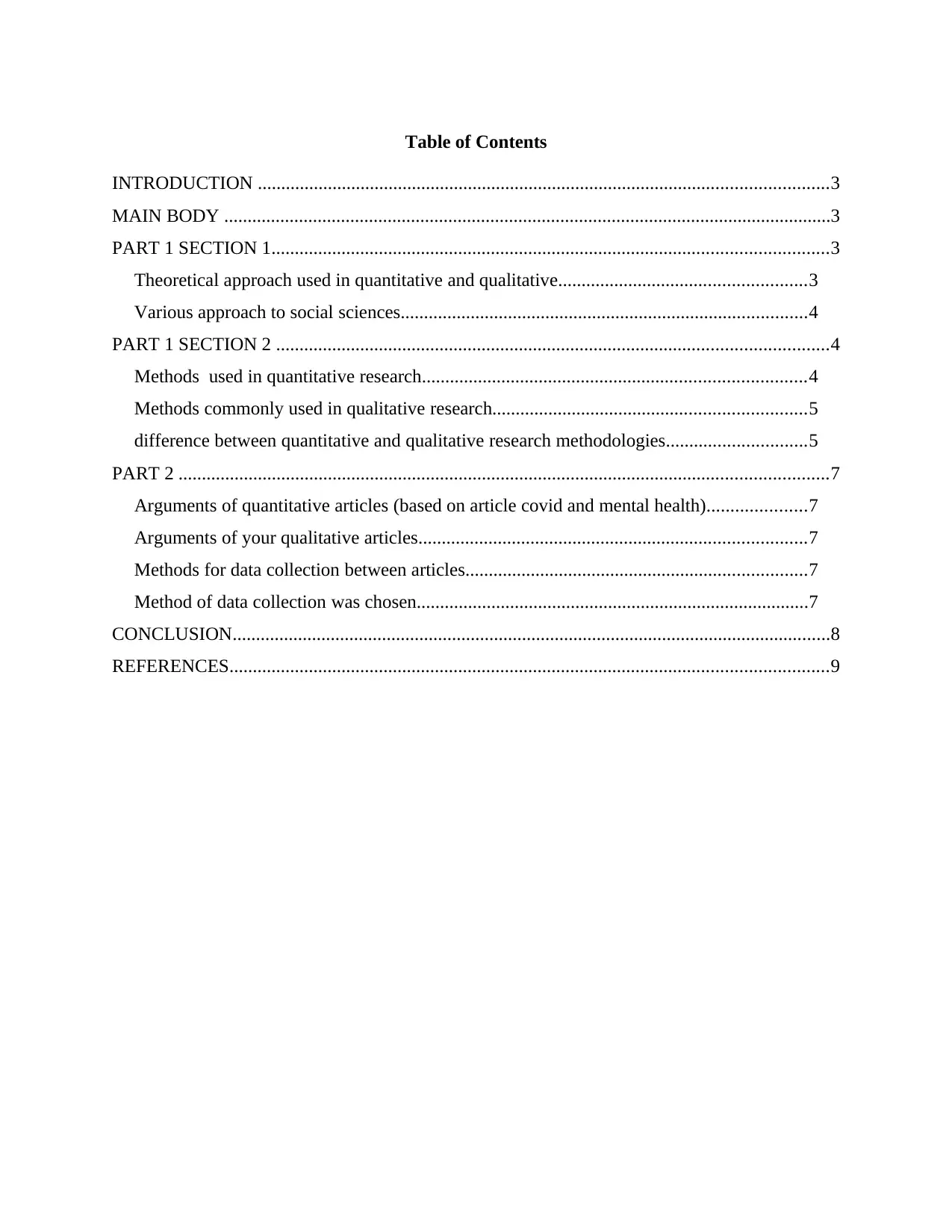
Table of Contents
INTRODUCTION ..........................................................................................................................3
MAIN BODY ..................................................................................................................................3
PART 1 SECTION 1.......................................................................................................................3
Theoretical approach used in quantitative and qualitative.....................................................3
Various approach to social sciences.......................................................................................4
PART 1 SECTION 2 ......................................................................................................................4
Methods used in quantitative research..................................................................................4
Methods commonly used in qualitative research...................................................................5
difference between quantitative and qualitative research methodologies..............................5
PART 2 ...........................................................................................................................................7
Arguments of quantitative articles (based on article covid and mental health).....................7
Arguments of your qualitative articles...................................................................................7
Methods for data collection between articles.........................................................................7
Method of data collection was chosen....................................................................................7
CONCLUSION................................................................................................................................8
REFERENCES................................................................................................................................9
INTRODUCTION ..........................................................................................................................3
MAIN BODY ..................................................................................................................................3
PART 1 SECTION 1.......................................................................................................................3
Theoretical approach used in quantitative and qualitative.....................................................3
Various approach to social sciences.......................................................................................4
PART 1 SECTION 2 ......................................................................................................................4
Methods used in quantitative research..................................................................................4
Methods commonly used in qualitative research...................................................................5
difference between quantitative and qualitative research methodologies..............................5
PART 2 ...........................................................................................................................................7
Arguments of quantitative articles (based on article covid and mental health).....................7
Arguments of your qualitative articles...................................................................................7
Methods for data collection between articles.........................................................................7
Method of data collection was chosen....................................................................................7
CONCLUSION................................................................................................................................8
REFERENCES................................................................................................................................9
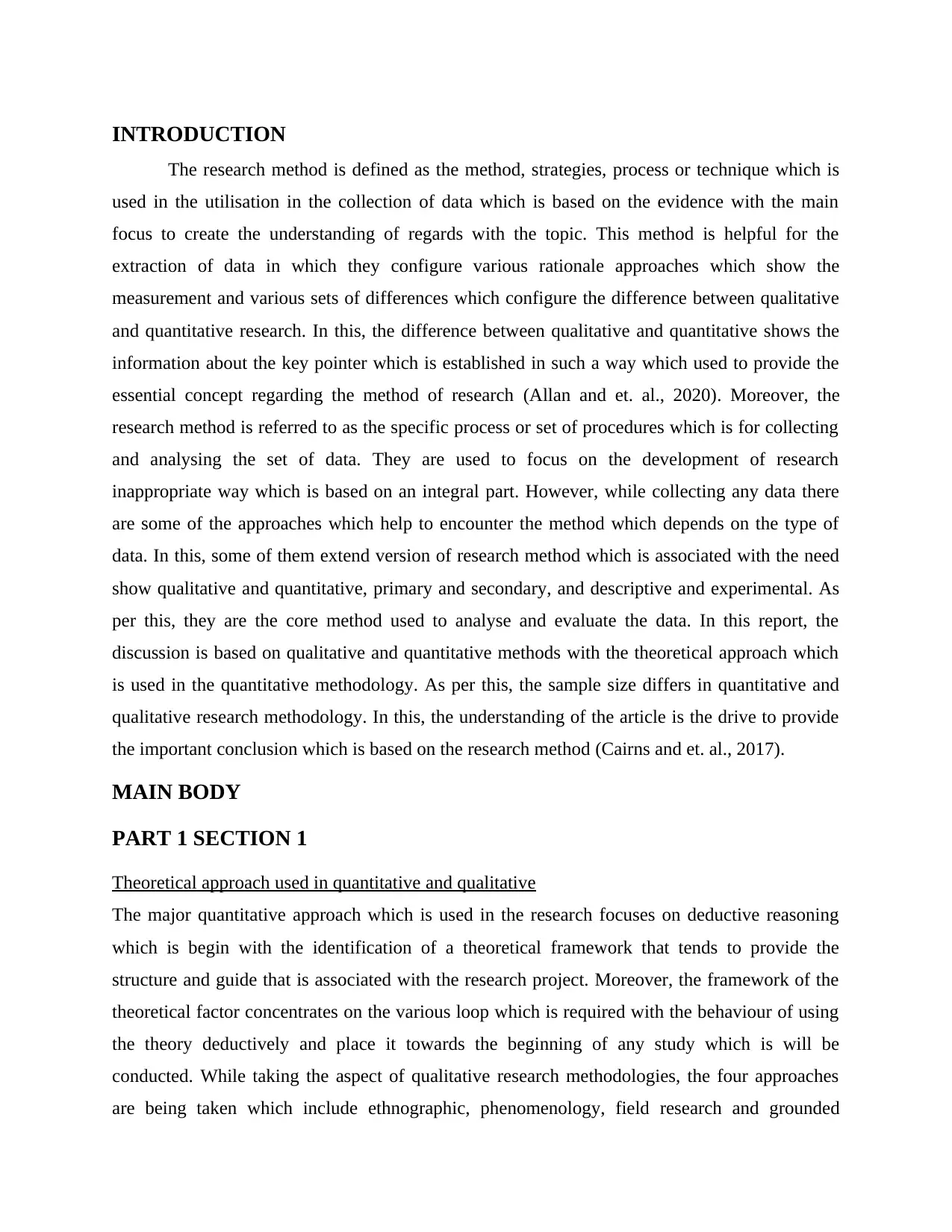
INTRODUCTION
The research method is defined as the method, strategies, process or technique which is
used in the utilisation in the collection of data which is based on the evidence with the main
focus to create the understanding of regards with the topic. This method is helpful for the
extraction of data in which they configure various rationale approaches which show the
measurement and various sets of differences which configure the difference between qualitative
and quantitative research. In this, the difference between qualitative and quantitative shows the
information about the key pointer which is established in such a way which used to provide the
essential concept regarding the method of research (Allan and et. al., 2020). Moreover, the
research method is referred to as the specific process or set of procedures which is for collecting
and analysing the set of data. They are used to focus on the development of research
inappropriate way which is based on an integral part. However, while collecting any data there
are some of the approaches which help to encounter the method which depends on the type of
data. In this, some of them extend version of research method which is associated with the need
show qualitative and quantitative, primary and secondary, and descriptive and experimental. As
per this, they are the core method used to analyse and evaluate the data. In this report, the
discussion is based on qualitative and quantitative methods with the theoretical approach which
is used in the quantitative methodology. As per this, the sample size differs in quantitative and
qualitative research methodology. In this, the understanding of the article is the drive to provide
the important conclusion which is based on the research method (Cairns and et. al., 2017).
MAIN BODY
PART 1 SECTION 1
Theoretical approach used in quantitative and qualitative
The major quantitative approach which is used in the research focuses on deductive reasoning
which is begin with the identification of a theoretical framework that tends to provide the
structure and guide that is associated with the research project. Moreover, the framework of the
theoretical factor concentrates on the various loop which is required with the behaviour of using
the theory deductively and place it towards the beginning of any study which is will be
conducted. While taking the aspect of qualitative research methodologies, the four approaches
are being taken which include ethnographic, phenomenology, field research and grounded
The research method is defined as the method, strategies, process or technique which is
used in the utilisation in the collection of data which is based on the evidence with the main
focus to create the understanding of regards with the topic. This method is helpful for the
extraction of data in which they configure various rationale approaches which show the
measurement and various sets of differences which configure the difference between qualitative
and quantitative research. In this, the difference between qualitative and quantitative shows the
information about the key pointer which is established in such a way which used to provide the
essential concept regarding the method of research (Allan and et. al., 2020). Moreover, the
research method is referred to as the specific process or set of procedures which is for collecting
and analysing the set of data. They are used to focus on the development of research
inappropriate way which is based on an integral part. However, while collecting any data there
are some of the approaches which help to encounter the method which depends on the type of
data. In this, some of them extend version of research method which is associated with the need
show qualitative and quantitative, primary and secondary, and descriptive and experimental. As
per this, they are the core method used to analyse and evaluate the data. In this report, the
discussion is based on qualitative and quantitative methods with the theoretical approach which
is used in the quantitative methodology. As per this, the sample size differs in quantitative and
qualitative research methodology. In this, the understanding of the article is the drive to provide
the important conclusion which is based on the research method (Cairns and et. al., 2017).
MAIN BODY
PART 1 SECTION 1
Theoretical approach used in quantitative and qualitative
The major quantitative approach which is used in the research focuses on deductive reasoning
which is begin with the identification of a theoretical framework that tends to provide the
structure and guide that is associated with the research project. Moreover, the framework of the
theoretical factor concentrates on the various loop which is required with the behaviour of using
the theory deductively and place it towards the beginning of any study which is will be
conducted. While taking the aspect of qualitative research methodologies, the four approaches
are being taken which include ethnographic, phenomenology, field research and grounded
⊘ This is a preview!⊘
Do you want full access?
Subscribe today to unlock all pages.

Trusted by 1+ million students worldwide
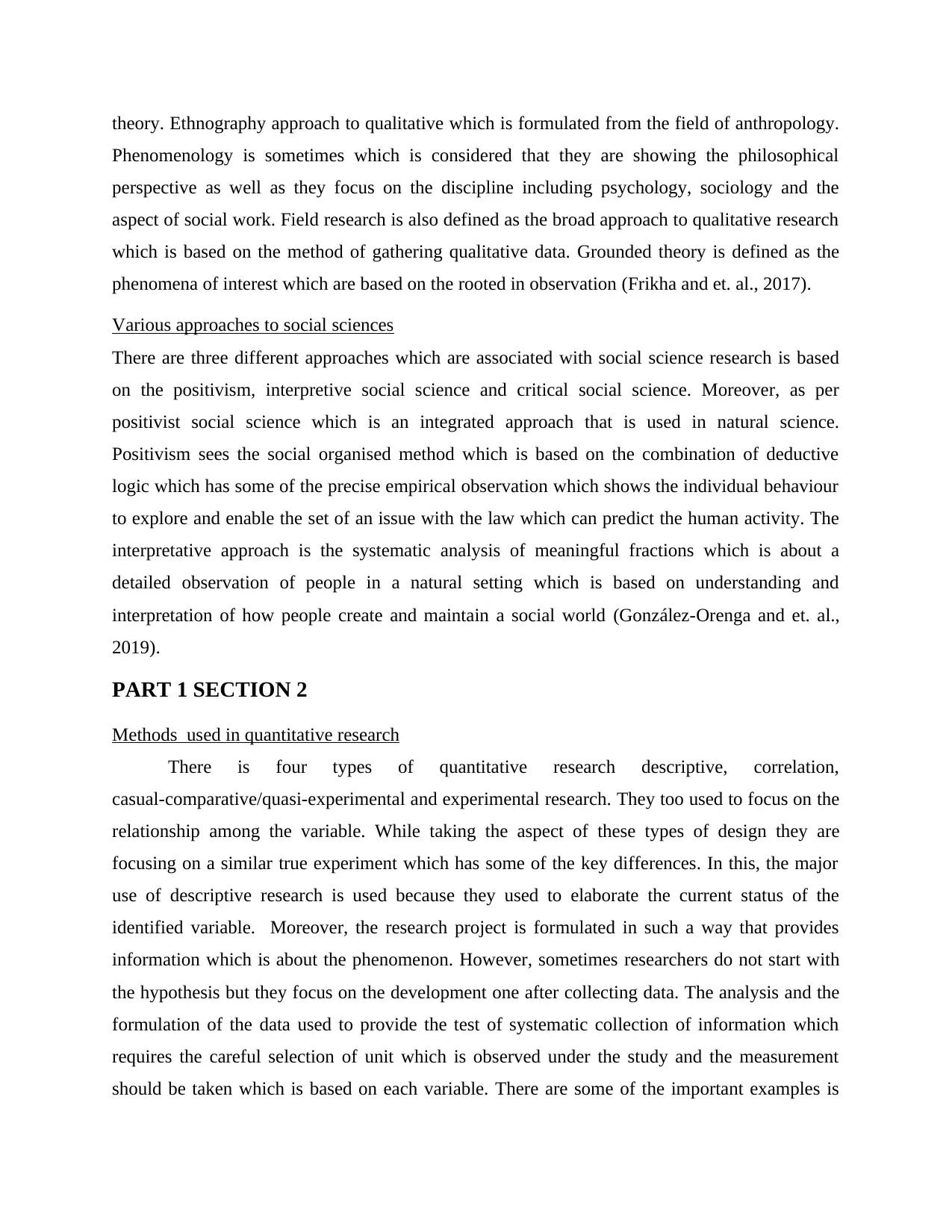
theory. Ethnography approach to qualitative which is formulated from the field of anthropology.
Phenomenology is sometimes which is considered that they are showing the philosophical
perspective as well as they focus on the discipline including psychology, sociology and the
aspect of social work. Field research is also defined as the broad approach to qualitative research
which is based on the method of gathering qualitative data. Grounded theory is defined as the
phenomena of interest which are based on the rooted in observation (Frikha and et. al., 2017).
Various approaches to social sciences
There are three different approaches which are associated with social science research is based
on the positivism, interpretive social science and critical social science. Moreover, as per
positivist social science which is an integrated approach that is used in natural science.
Positivism sees the social organised method which is based on the combination of deductive
logic which has some of the precise empirical observation which shows the individual behaviour
to explore and enable the set of an issue with the law which can predict the human activity. The
interpretative approach is the systematic analysis of meaningful fractions which is about a
detailed observation of people in a natural setting which is based on understanding and
interpretation of how people create and maintain a social world (González-Orenga and et. al.,
2019).
PART 1 SECTION 2
Methods used in quantitative research
There is four types of quantitative research descriptive, correlation,
casual-comparative/quasi-experimental and experimental research. They too used to focus on the
relationship among the variable. While taking the aspect of these types of design they are
focusing on a similar true experiment which has some of the key differences. In this, the major
use of descriptive research is used because they used to elaborate the current status of the
identified variable. Moreover, the research project is formulated in such a way that provides
information which is about the phenomenon. However, sometimes researchers do not start with
the hypothesis but they focus on the development one after collecting data. The analysis and the
formulation of the data used to provide the test of systematic collection of information which
requires the careful selection of unit which is observed under the study and the measurement
should be taken which is based on each variable. There are some of the important examples is
Phenomenology is sometimes which is considered that they are showing the philosophical
perspective as well as they focus on the discipline including psychology, sociology and the
aspect of social work. Field research is also defined as the broad approach to qualitative research
which is based on the method of gathering qualitative data. Grounded theory is defined as the
phenomena of interest which are based on the rooted in observation (Frikha and et. al., 2017).
Various approaches to social sciences
There are three different approaches which are associated with social science research is based
on the positivism, interpretive social science and critical social science. Moreover, as per
positivist social science which is an integrated approach that is used in natural science.
Positivism sees the social organised method which is based on the combination of deductive
logic which has some of the precise empirical observation which shows the individual behaviour
to explore and enable the set of an issue with the law which can predict the human activity. The
interpretative approach is the systematic analysis of meaningful fractions which is about a
detailed observation of people in a natural setting which is based on understanding and
interpretation of how people create and maintain a social world (González-Orenga and et. al.,
2019).
PART 1 SECTION 2
Methods used in quantitative research
There is four types of quantitative research descriptive, correlation,
casual-comparative/quasi-experimental and experimental research. They too used to focus on the
relationship among the variable. While taking the aspect of these types of design they are
focusing on a similar true experiment which has some of the key differences. In this, the major
use of descriptive research is used because they used to elaborate the current status of the
identified variable. Moreover, the research project is formulated in such a way that provides
information which is about the phenomenon. However, sometimes researchers do not start with
the hypothesis but they focus on the development one after collecting data. The analysis and the
formulation of the data used to provide the test of systematic collection of information which
requires the careful selection of unit which is observed under the study and the measurement
should be taken which is based on each variable. There are some of the important examples is
Paraphrase This Document
Need a fresh take? Get an instant paraphrase of this document with our AI Paraphraser
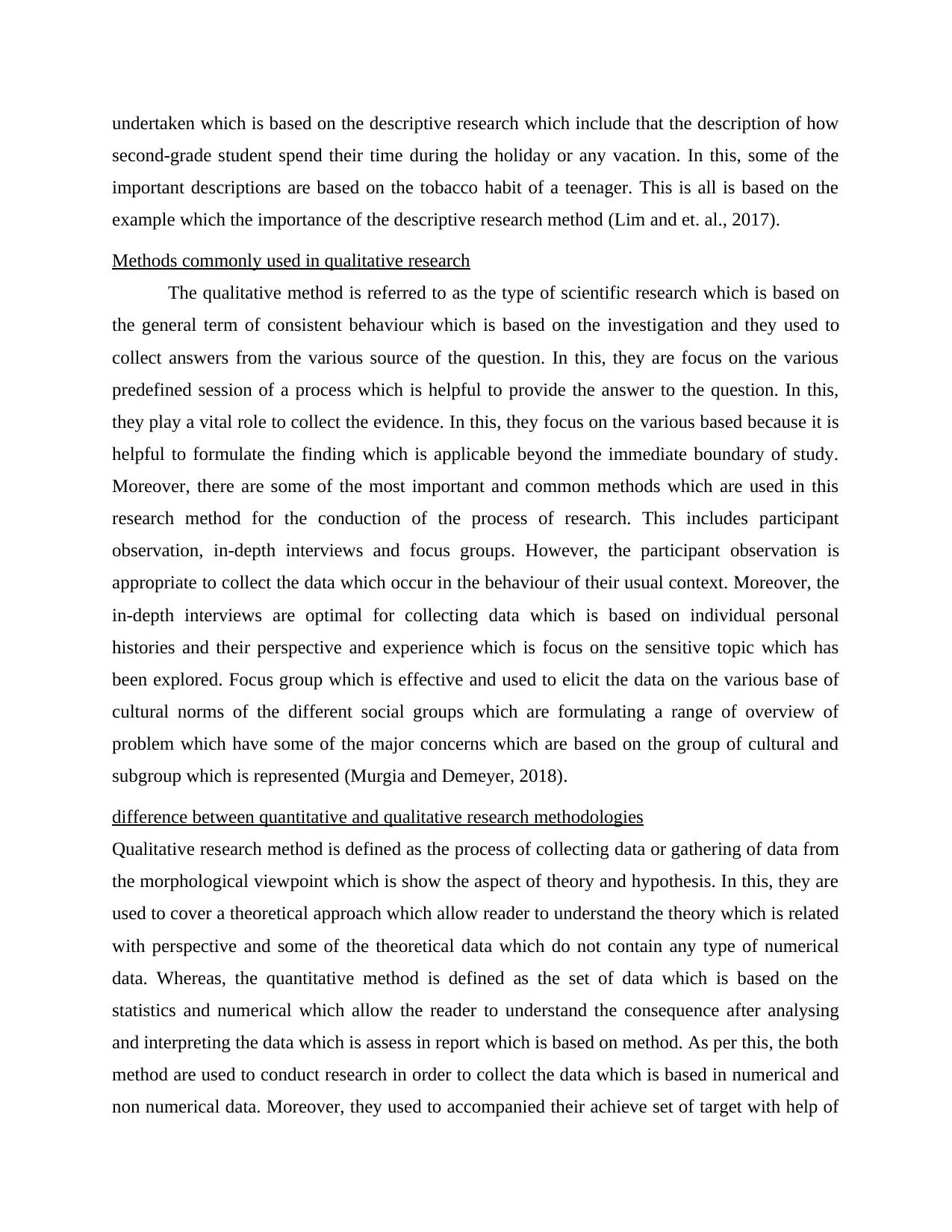
undertaken which is based on the descriptive research which include that the description of how
second-grade student spend their time during the holiday or any vacation. In this, some of the
important descriptions are based on the tobacco habit of a teenager. This is all is based on the
example which the importance of the descriptive research method (Lim and et. al., 2017).
Methods commonly used in qualitative research
The qualitative method is referred to as the type of scientific research which is based on
the general term of consistent behaviour which is based on the investigation and they used to
collect answers from the various source of the question. In this, they are focus on the various
predefined session of a process which is helpful to provide the answer to the question. In this,
they play a vital role to collect the evidence. In this, they focus on the various based because it is
helpful to formulate the finding which is applicable beyond the immediate boundary of study.
Moreover, there are some of the most important and common methods which are used in this
research method for the conduction of the process of research. This includes participant
observation, in-depth interviews and focus groups. However, the participant observation is
appropriate to collect the data which occur in the behaviour of their usual context. Moreover, the
in-depth interviews are optimal for collecting data which is based on individual personal
histories and their perspective and experience which is focus on the sensitive topic which has
been explored. Focus group which is effective and used to elicit the data on the various base of
cultural norms of the different social groups which are formulating a range of overview of
problem which have some of the major concerns which are based on the group of cultural and
subgroup which is represented (Murgia and Demeyer, 2018).
difference between quantitative and qualitative research methodologies
Qualitative research method is defined as the process of collecting data or gathering of data from
the morphological viewpoint which is show the aspect of theory and hypothesis. In this, they are
used to cover a theoretical approach which allow reader to understand the theory which is related
with perspective and some of the theoretical data which do not contain any type of numerical
data. Whereas, the quantitative method is defined as the set of data which is based on the
statistics and numerical which allow the reader to understand the consequence after analysing
and interpreting the data which is assess in report which is based on method. As per this, the both
method are used to conduct research in order to collect the data which is based in numerical and
non numerical data. Moreover, they used to accompanied their achieve set of target with help of
second-grade student spend their time during the holiday or any vacation. In this, some of the
important descriptions are based on the tobacco habit of a teenager. This is all is based on the
example which the importance of the descriptive research method (Lim and et. al., 2017).
Methods commonly used in qualitative research
The qualitative method is referred to as the type of scientific research which is based on
the general term of consistent behaviour which is based on the investigation and they used to
collect answers from the various source of the question. In this, they are focus on the various
predefined session of a process which is helpful to provide the answer to the question. In this,
they play a vital role to collect the evidence. In this, they focus on the various based because it is
helpful to formulate the finding which is applicable beyond the immediate boundary of study.
Moreover, there are some of the most important and common methods which are used in this
research method for the conduction of the process of research. This includes participant
observation, in-depth interviews and focus groups. However, the participant observation is
appropriate to collect the data which occur in the behaviour of their usual context. Moreover, the
in-depth interviews are optimal for collecting data which is based on individual personal
histories and their perspective and experience which is focus on the sensitive topic which has
been explored. Focus group which is effective and used to elicit the data on the various base of
cultural norms of the different social groups which are formulating a range of overview of
problem which have some of the major concerns which are based on the group of cultural and
subgroup which is represented (Murgia and Demeyer, 2018).
difference between quantitative and qualitative research methodologies
Qualitative research method is defined as the process of collecting data or gathering of data from
the morphological viewpoint which is show the aspect of theory and hypothesis. In this, they are
used to cover a theoretical approach which allow reader to understand the theory which is related
with perspective and some of the theoretical data which do not contain any type of numerical
data. Whereas, the quantitative method is defined as the set of data which is based on the
statistics and numerical which allow the reader to understand the consequence after analysing
and interpreting the data which is assess in report which is based on method. As per this, the both
method are used to conduct research in order to collect the data which is based in numerical and
non numerical data. Moreover, they used to accompanied their achieve set of target with help of
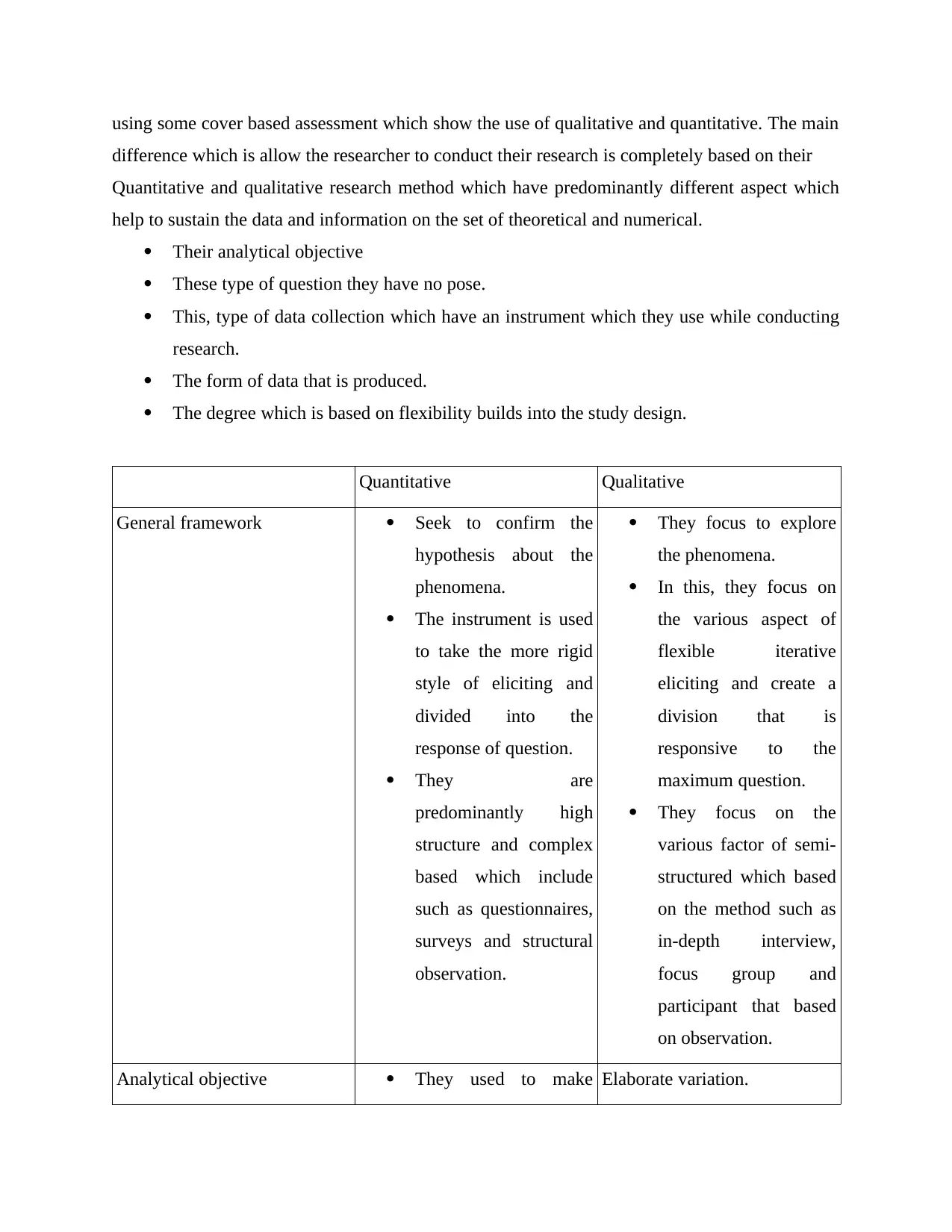
using some cover based assessment which show the use of qualitative and quantitative. The main
difference which is allow the researcher to conduct their research is completely based on their
Quantitative and qualitative research method which have predominantly different aspect which
help to sustain the data and information on the set of theoretical and numerical.
Their analytical objective
These type of question they have no pose.
This, type of data collection which have an instrument which they use while conducting
research.
The form of data that is produced.
The degree which is based on flexibility builds into the study design.
Quantitative Qualitative
General framework Seek to confirm the
hypothesis about the
phenomena.
The instrument is used
to take the more rigid
style of eliciting and
divided into the
response of question.
They are
predominantly high
structure and complex
based which include
such as questionnaires,
surveys and structural
observation.
They focus to explore
the phenomena.
In this, they focus on
the various aspect of
flexible iterative
eliciting and create a
division that is
responsive to the
maximum question.
They focus on the
various factor of semi-
structured which based
on the method such as
in-depth interview,
focus group and
participant that based
on observation.
Analytical objective They used to make Elaborate variation.
difference which is allow the researcher to conduct their research is completely based on their
Quantitative and qualitative research method which have predominantly different aspect which
help to sustain the data and information on the set of theoretical and numerical.
Their analytical objective
These type of question they have no pose.
This, type of data collection which have an instrument which they use while conducting
research.
The form of data that is produced.
The degree which is based on flexibility builds into the study design.
Quantitative Qualitative
General framework Seek to confirm the
hypothesis about the
phenomena.
The instrument is used
to take the more rigid
style of eliciting and
divided into the
response of question.
They are
predominantly high
structure and complex
based which include
such as questionnaires,
surveys and structural
observation.
They focus to explore
the phenomena.
In this, they focus on
the various aspect of
flexible iterative
eliciting and create a
division that is
responsive to the
maximum question.
They focus on the
various factor of semi-
structured which based
on the method such as
in-depth interview,
focus group and
participant that based
on observation.
Analytical objective They used to make Elaborate variation.
⊘ This is a preview!⊘
Do you want full access?
Subscribe today to unlock all pages.

Trusted by 1+ million students worldwide
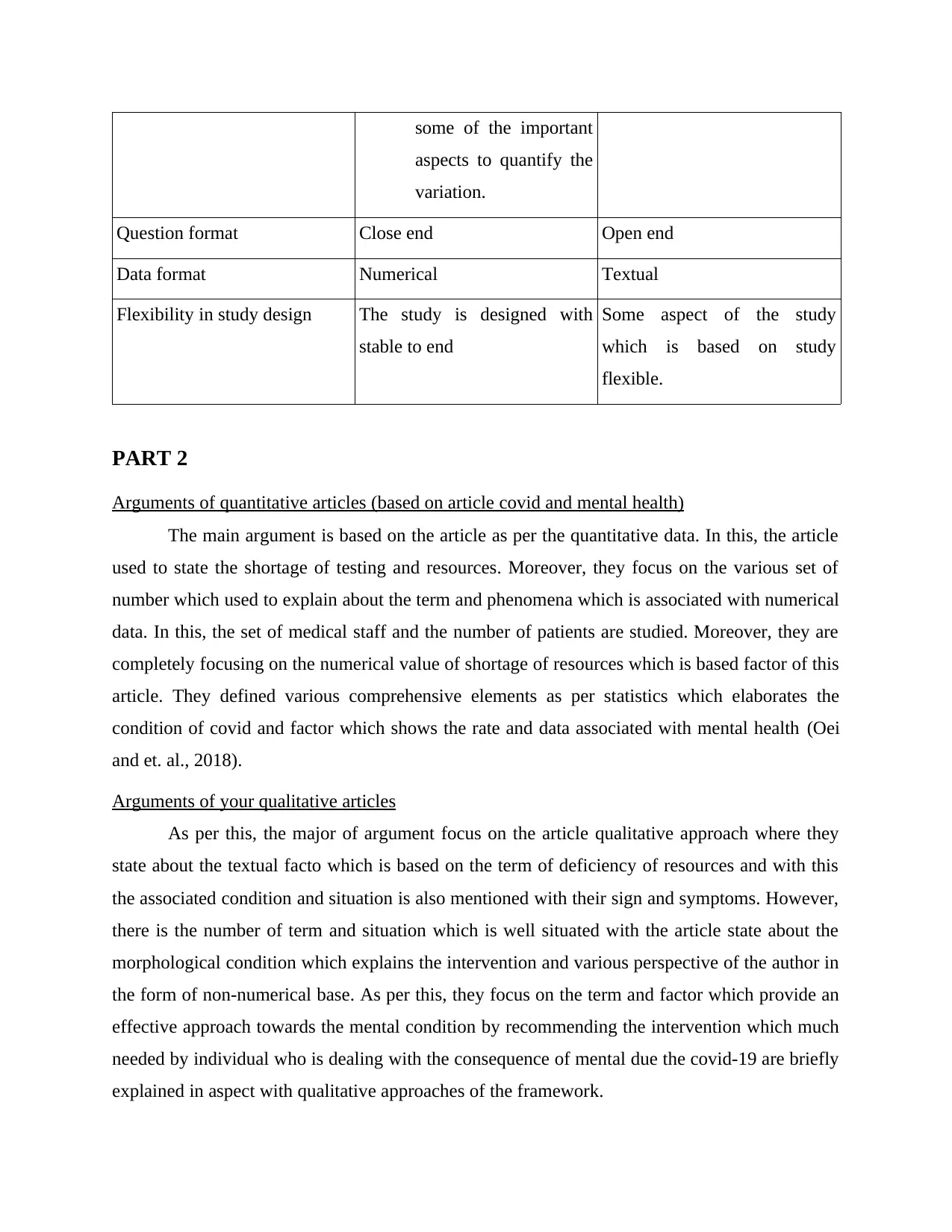
some of the important
aspects to quantify the
variation.
Question format Close end Open end
Data format Numerical Textual
Flexibility in study design The study is designed with
stable to end
Some aspect of the study
which is based on study
flexible.
PART 2
Arguments of quantitative articles (based on article covid and mental health)
The main argument is based on the article as per the quantitative data. In this, the article
used to state the shortage of testing and resources. Moreover, they focus on the various set of
number which used to explain about the term and phenomena which is associated with numerical
data. In this, the set of medical staff and the number of patients are studied. Moreover, they are
completely focusing on the numerical value of shortage of resources which is based factor of this
article. They defined various comprehensive elements as per statistics which elaborates the
condition of covid and factor which shows the rate and data associated with mental health (Oei
and et. al., 2018).
Arguments of your qualitative articles
As per this, the major of argument focus on the article qualitative approach where they
state about the textual facto which is based on the term of deficiency of resources and with this
the associated condition and situation is also mentioned with their sign and symptoms. However,
there is the number of term and situation which is well situated with the article state about the
morphological condition which explains the intervention and various perspective of the author in
the form of non-numerical base. As per this, they focus on the term and factor which provide an
effective approach towards the mental condition by recommending the intervention which much
needed by individual who is dealing with the consequence of mental due the covid-19 are briefly
explained in aspect with qualitative approaches of the framework.
aspects to quantify the
variation.
Question format Close end Open end
Data format Numerical Textual
Flexibility in study design The study is designed with
stable to end
Some aspect of the study
which is based on study
flexible.
PART 2
Arguments of quantitative articles (based on article covid and mental health)
The main argument is based on the article as per the quantitative data. In this, the article
used to state the shortage of testing and resources. Moreover, they focus on the various set of
number which used to explain about the term and phenomena which is associated with numerical
data. In this, the set of medical staff and the number of patients are studied. Moreover, they are
completely focusing on the numerical value of shortage of resources which is based factor of this
article. They defined various comprehensive elements as per statistics which elaborates the
condition of covid and factor which shows the rate and data associated with mental health (Oei
and et. al., 2018).
Arguments of your qualitative articles
As per this, the major of argument focus on the article qualitative approach where they
state about the textual facto which is based on the term of deficiency of resources and with this
the associated condition and situation is also mentioned with their sign and symptoms. However,
there is the number of term and situation which is well situated with the article state about the
morphological condition which explains the intervention and various perspective of the author in
the form of non-numerical base. As per this, they focus on the term and factor which provide an
effective approach towards the mental condition by recommending the intervention which much
needed by individual who is dealing with the consequence of mental due the covid-19 are briefly
explained in aspect with qualitative approaches of the framework.
Paraphrase This Document
Need a fresh take? Get an instant paraphrase of this document with our AI Paraphraser
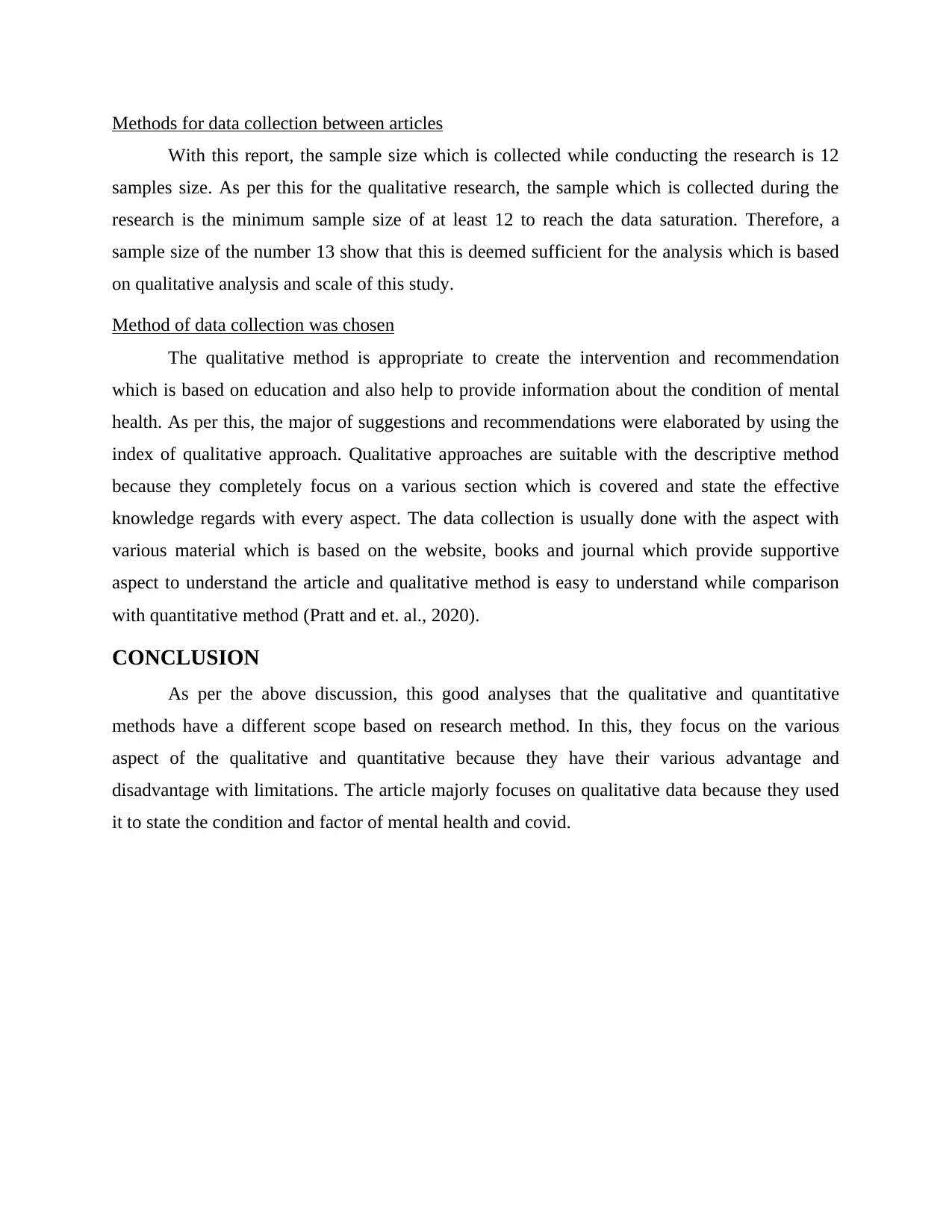
Methods for data collection between articles
With this report, the sample size which is collected while conducting the research is 12
samples size. As per this for the qualitative research, the sample which is collected during the
research is the minimum sample size of at least 12 to reach the data saturation. Therefore, a
sample size of the number 13 show that this is deemed sufficient for the analysis which is based
on qualitative analysis and scale of this study.
Method of data collection was chosen
The qualitative method is appropriate to create the intervention and recommendation
which is based on education and also help to provide information about the condition of mental
health. As per this, the major of suggestions and recommendations were elaborated by using the
index of qualitative approach. Qualitative approaches are suitable with the descriptive method
because they completely focus on a various section which is covered and state the effective
knowledge regards with every aspect. The data collection is usually done with the aspect with
various material which is based on the website, books and journal which provide supportive
aspect to understand the article and qualitative method is easy to understand while comparison
with quantitative method (Pratt and et. al., 2020).
CONCLUSION
As per the above discussion, this good analyses that the qualitative and quantitative
methods have a different scope based on research method. In this, they focus on the various
aspect of the qualitative and quantitative because they have their various advantage and
disadvantage with limitations. The article majorly focuses on qualitative data because they used
it to state the condition and factor of mental health and covid.
With this report, the sample size which is collected while conducting the research is 12
samples size. As per this for the qualitative research, the sample which is collected during the
research is the minimum sample size of at least 12 to reach the data saturation. Therefore, a
sample size of the number 13 show that this is deemed sufficient for the analysis which is based
on qualitative analysis and scale of this study.
Method of data collection was chosen
The qualitative method is appropriate to create the intervention and recommendation
which is based on education and also help to provide information about the condition of mental
health. As per this, the major of suggestions and recommendations were elaborated by using the
index of qualitative approach. Qualitative approaches are suitable with the descriptive method
because they completely focus on a various section which is covered and state the effective
knowledge regards with every aspect. The data collection is usually done with the aspect with
various material which is based on the website, books and journal which provide supportive
aspect to understand the article and qualitative method is easy to understand while comparison
with quantitative method (Pratt and et. al., 2020).
CONCLUSION
As per the above discussion, this good analyses that the qualitative and quantitative
methods have a different scope based on research method. In this, they focus on the various
aspect of the qualitative and quantitative because they have their various advantage and
disadvantage with limitations. The article majorly focuses on qualitative data because they used
it to state the condition and factor of mental health and covid.
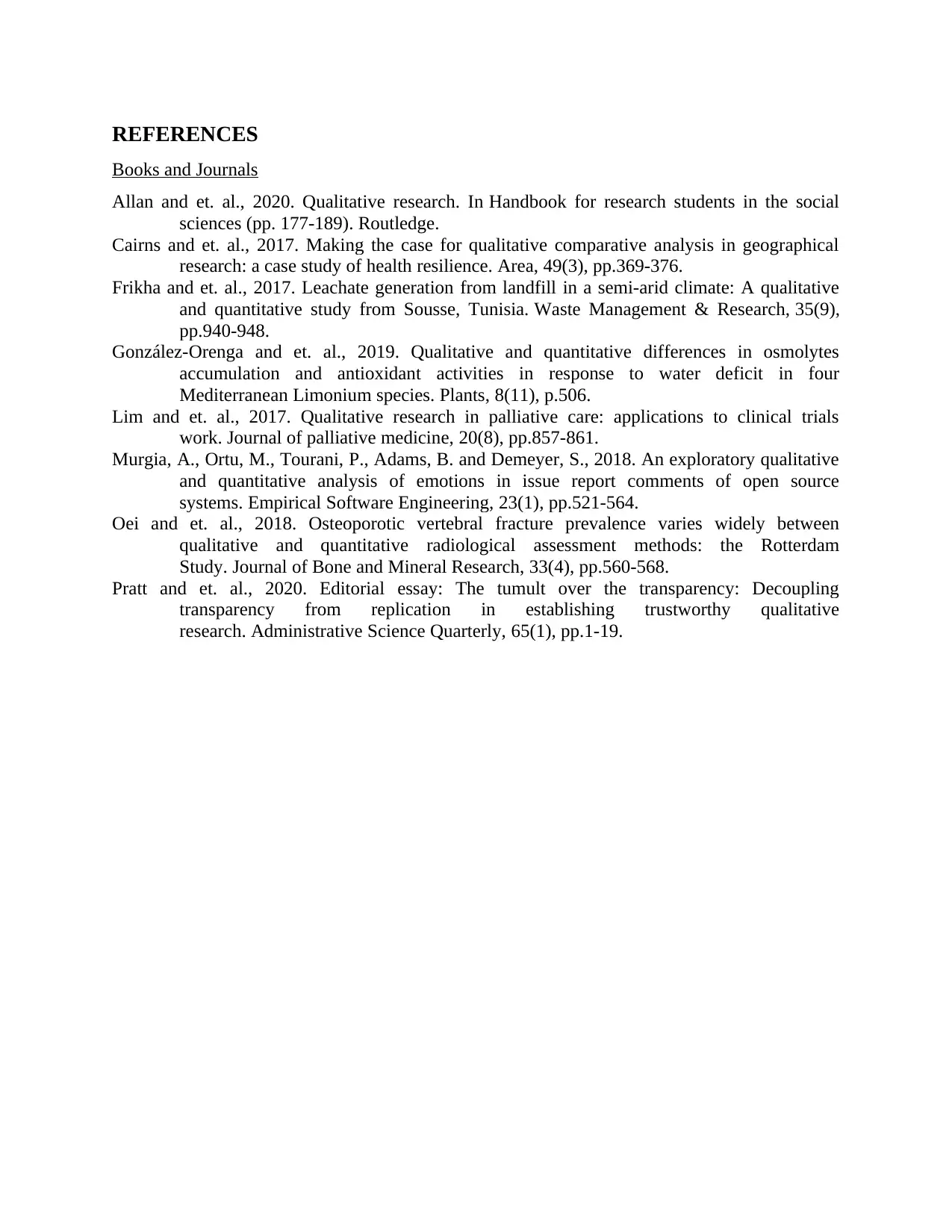
REFERENCES
Books and Journals
Allan and et. al., 2020. Qualitative research. In Handbook for research students in the social
sciences (pp. 177-189). Routledge.
Cairns and et. al., 2017. Making the case for qualitative comparative analysis in geographical
research: a case study of health resilience. Area, 49(3), pp.369-376.
Frikha and et. al., 2017. Leachate generation from landfill in a semi-arid climate: A qualitative
and quantitative study from Sousse, Tunisia. Waste Management & Research, 35(9),
pp.940-948.
González-Orenga and et. al., 2019. Qualitative and quantitative differences in osmolytes
accumulation and antioxidant activities in response to water deficit in four
Mediterranean Limonium species. Plants, 8(11), p.506.
Lim and et. al., 2017. Qualitative research in palliative care: applications to clinical trials
work. Journal of palliative medicine, 20(8), pp.857-861.
Murgia, A., Ortu, M., Tourani, P., Adams, B. and Demeyer, S., 2018. An exploratory qualitative
and quantitative analysis of emotions in issue report comments of open source
systems. Empirical Software Engineering, 23(1), pp.521-564.
Oei and et. al., 2018. Osteoporotic vertebral fracture prevalence varies widely between
qualitative and quantitative radiological assessment methods: the Rotterdam
Study. Journal of Bone and Mineral Research, 33(4), pp.560-568.
Pratt and et. al., 2020. Editorial essay: The tumult over the transparency: Decoupling
transparency from replication in establishing trustworthy qualitative
research. Administrative Science Quarterly, 65(1), pp.1-19.
Books and Journals
Allan and et. al., 2020. Qualitative research. In Handbook for research students in the social
sciences (pp. 177-189). Routledge.
Cairns and et. al., 2017. Making the case for qualitative comparative analysis in geographical
research: a case study of health resilience. Area, 49(3), pp.369-376.
Frikha and et. al., 2017. Leachate generation from landfill in a semi-arid climate: A qualitative
and quantitative study from Sousse, Tunisia. Waste Management & Research, 35(9),
pp.940-948.
González-Orenga and et. al., 2019. Qualitative and quantitative differences in osmolytes
accumulation and antioxidant activities in response to water deficit in four
Mediterranean Limonium species. Plants, 8(11), p.506.
Lim and et. al., 2017. Qualitative research in palliative care: applications to clinical trials
work. Journal of palliative medicine, 20(8), pp.857-861.
Murgia, A., Ortu, M., Tourani, P., Adams, B. and Demeyer, S., 2018. An exploratory qualitative
and quantitative analysis of emotions in issue report comments of open source
systems. Empirical Software Engineering, 23(1), pp.521-564.
Oei and et. al., 2018. Osteoporotic vertebral fracture prevalence varies widely between
qualitative and quantitative radiological assessment methods: the Rotterdam
Study. Journal of Bone and Mineral Research, 33(4), pp.560-568.
Pratt and et. al., 2020. Editorial essay: The tumult over the transparency: Decoupling
transparency from replication in establishing trustworthy qualitative
research. Administrative Science Quarterly, 65(1), pp.1-19.
⊘ This is a preview!⊘
Do you want full access?
Subscribe today to unlock all pages.

Trusted by 1+ million students worldwide
1 out of 9
Related Documents
Your All-in-One AI-Powered Toolkit for Academic Success.
+13062052269
info@desklib.com
Available 24*7 on WhatsApp / Email
![[object Object]](/_next/static/media/star-bottom.7253800d.svg)
Unlock your academic potential
Copyright © 2020–2025 A2Z Services. All Rights Reserved. Developed and managed by ZUCOL.





